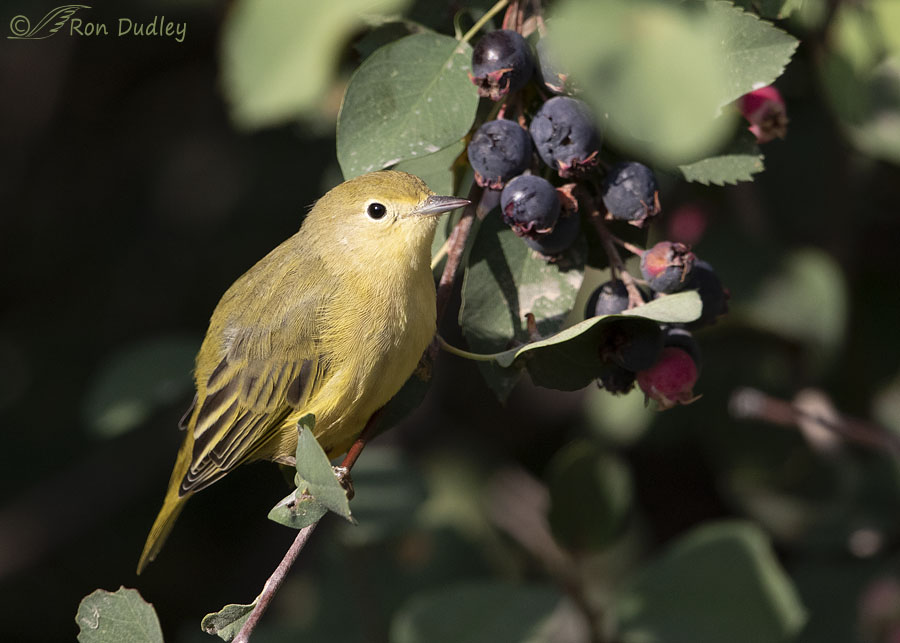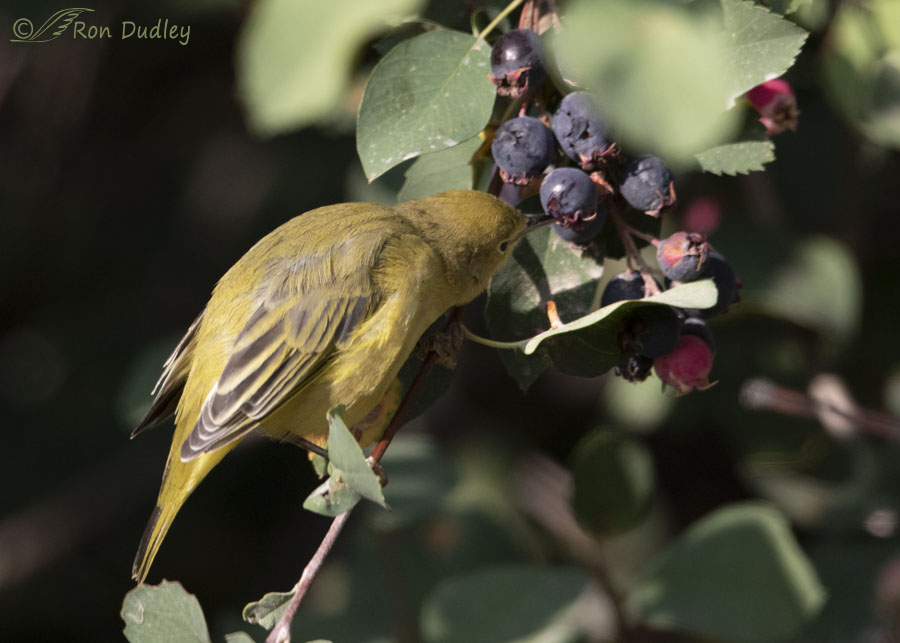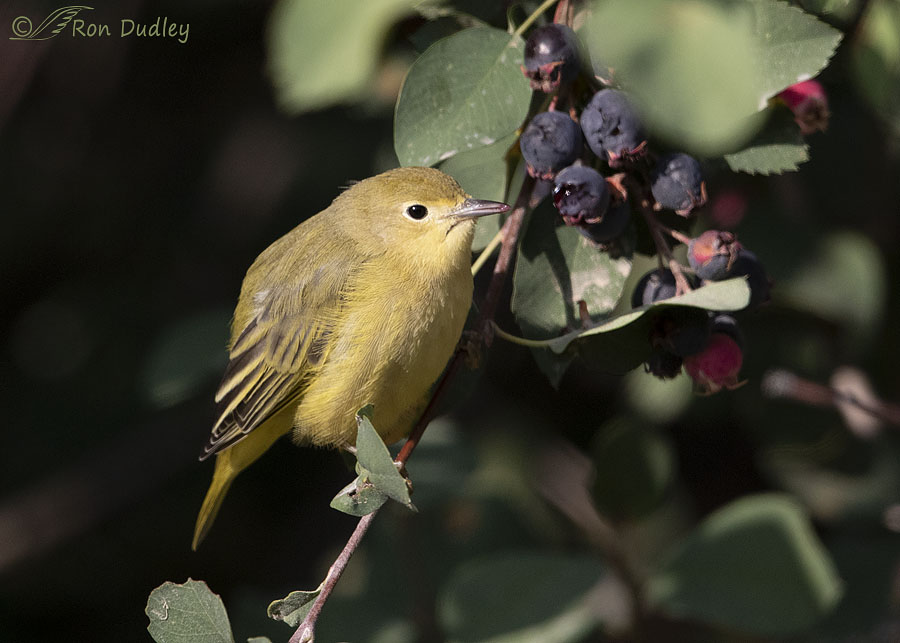Yellow Warblers are known to eat insects and spiders almost exclusively. This one didn’t get the message.

1/2000, f/6.3, ISO 800, Canon 7D Mark II, Canon EF 500mm f/4L IS II USM + EF 1.4 III Extender, not baited, set up or called in
One year ago today I photographed this Yellow Warbler doing two things out of the ordinary. First off he was being what I call “sticky,” meaning he stayed in the same spot for a long time. If you know anything about warblers in general and Yellow Warblers in particular you’re aware that they’re among the flittiest birds out there as they constantly move from perch to perch in their search for tiny insects. I’d estimate that while they’re gleaning insects the average time they spend in one spot is about 2-3 seconds which usually isn’t quite long enough for me to get my lens on the bird, focus and fire the shutter. Having the bird move or fly out of the frame just before I press the shutter button is the norm rather than the exception.
But this guy stayed in the same spot for so long I was able to take 154 shots of him. I was amazed because many of those photos were single shots rather than part of a burst. So the obvious question is… What made him stay?
He stayed because he was eating fruit – serviceberries in this instance. In my experience it’s almost unheard of for this species to eat anything but insects and spiders but there’s no question that he was eating berries, in this case the berry directly in front of his bill. He had pierced its skin with his bill so he could get at the juicy pulp inside. If you look carefully you can see the wound on the berry.

1/2000, f/6.3, ISO 800, Canon 7D Mark II, Canon EF 500mm f/4L IS II USM + EF 1.4 III Extender, not baited, set up or called in
Of course I didn’t have eye contact or good light on his face when he’d take a bite but photos like this one documented what was really happening. At first I was suspicious that he was picking tiny insects off of the berry but close looks at some of my photos confirmed otherwise.

1/3200, f/6.3, ISO 800, Canon 7D Mark II, Canon EF 500mm f/4L IS II USM + EF 1.4 III Extender, not baited, set up or called in
In many of my photos he had berry juice on the end of his bill and in this one we see a bit of pulp there too. And the wound on the berry became progressively larger over time as he fed.
I wouldn’t call this behavior rare but I suspect it’s pretty unusual, especially to document it conclusively with photos. Here’s what Cornell’s Birds of North America Online (a pay site) has to say about the diet of Yellow Warblers: “Insects and other arthropods: may take wild fruits occasionally.”
And their almost exclusively insect diet is the reason that Yellow Warblers rarely if ever come to feeders, even though they may be common in the area. A frustrating fact of life for many folks who like to watch birds at their feeders.
Ron


Great captures!
Ron, love your photos and interesting narrative. I’m recovering from some surgery so will enjoy your postings, more than ever in the next month or so. Thank you, Ron
Thanks, Alice. I hope your recovery is quick and uneventful.
I know that you know all about this and worse. Thanks for your thoughts!! I have good Doctor’s at the U that I have confidence in. Life is a journey, isn’t it?
Rarely see Yellow Warblers, let alone eating. Great catch, Ron. So, this bird would be:
an omnivore,
less or more,
exhibiting frugivory,
as your post does bore,
but not a frugivore:
fruit’s a treat, but not much more,
possibly takes part in granivory*?
That’s a -vory to explore.
*see Ron’s 8/9/19 post for a granivore
but not a granivore
Yup, more or less…
Lovely photos! You caught an interesting behavior. It is interesting to see how they can change eating habits and seem to be naturals at it especially when their normal food sources are plentiful. It is a sorry time of year when we see them start to gather for their migration. Last year’s spring brought a nasty amount of snow and the birds that normally foraged for worms, ground insects, etc had a hard time. It was amazing to see how many went after seed that normally shun it but that was in extraordinary circumstances. There is a robin that visits my feeders for sunnies…I don’t know why he does it…flies in, sits in a tray feeder looking around for a while and then eats to his heart’s content. Sometimes I surmise he is looking to be sure no one is watching him.
You caught an interesting behavior. It is interesting to see how they can change eating habits and seem to be naturals at it especially when their normal food sources are plentiful. It is a sorry time of year when we see them start to gather for their migration. Last year’s spring brought a nasty amount of snow and the birds that normally foraged for worms, ground insects, etc had a hard time. It was amazing to see how many went after seed that normally shun it but that was in extraordinary circumstances. There is a robin that visits my feeders for sunnies…I don’t know why he does it…flies in, sits in a tray feeder looking around for a while and then eats to his heart’s content. Sometimes I surmise he is looking to be sure no one is watching him. 
Kathy, like so many other critters birds do what they have to do.
I suspect that anomalies like this one are quite often picked up by dedicated (and knowledgeable) people like yourself. And hope it enjoyed its excursion into vegetarianism (which some members of my family consider a walk on the dark side).
Wonderful detail in those shots. Thank you. As always.
EC, I’d miss noticing nearly all of these “anomalies” without the aid of my lens, especially with these old eyes…
Wonderful photos! love the colors and light.
I’m glad you like them, April. Thanks.
Ron I can almost taste his pleasure in your photos. Thanks Diana
Then the photos work. Thanks, Diana.
Wonderful series Ron!
Charlotte
Thanks, Charlotte.
Nice little bit of science with your wonderful photos! But what else would we expect from a former biology teacher? Thanks, Ron.
Thank you, Nancy. You can take the teacher out of the classroom but…
What can I say but, I love your photos! Wish I had the money and time to convince you to put a book together. Yes, I know that isn’t going to happen, but had to say it anyway.
Animals have different likes and dislikes, and part of the game is to observe what others are doing, with some individuals taking a leap from what they are used to doing and trying something else, something new. I personally think there are individual birds of species where we (humans) think will only do what we have read about or seen them do, will in fact, try something entirely different. Plus, we all live in a changing world!
I agree with you about individual birds varying from the norm, Dick. That’s how birds, as individuals or as species, can adapt to changing conditions when they need to.
“Having the bird move or fly out of the frame just before I press the shutter button is the norm rather than the exception.” That sentence says it all for bird photographers Ron. On a couple recent occasions I ran into birds eating berries or something else and I was able to take numerous uninterrupted photos. One I remember was a Ladder-backed Woodpecker. I must have taken fifty shots and he was still eating when I left. It’s interesting that the Warbler just picks at the berries. I’ve seen many larger birds just eat the whole berry. Thanks for posting this interesting series.
“It’s interesting that the Warbler just picks at the berries”
Yup, those berries are just too large for a bird this size to swallow whole. I’ve photographed several other species doing the same thing. Thanks, Everett.
Interesting! And great capture of the behavior…. The fact it was eating does indicate it wasn’t hurt or ill I would say. The most we see them occasionally is if they are on the windowsill of a picture window gathering spider webs in the spring…… Good they have some flexibility on diet. On that note we got a Nighthawk imitating a snapping turtle yesterday – DAMN do they have a big mouth to go with that tiny bill and a pretty good hiss also!
The fact it was eating does indicate it wasn’t hurt or ill I would say. The most we see them occasionally is if they are on the windowsill of a picture window gathering spider webs in the spring…… Good they have some flexibility on diet. On that note we got a Nighthawk imitating a snapping turtle yesterday – DAMN do they have a big mouth to go with that tiny bill and a pretty good hiss also!  Apparently this one had hit one of the power lines and messed up wing – it’s gone this morning after a days rest undercover and “perching” it on a large, horizontal cottonwood log that’s pretty low to the ground – no real way to feed it.
Apparently this one had hit one of the power lines and messed up wing – it’s gone this morning after a days rest undercover and “perching” it on a large, horizontal cottonwood log that’s pretty low to the ground – no real way to feed it.  Wing didn’t seem to be broken BUT!
Wing didn’t seem to be broken BUT!
I’m pretty sure this bird was healthy and feeling fine, Judy.
One of my many unfulfilled goals is to get good flight shots of nighthawks.
“Good” is the operative word! They are amazing in flight and in low light the white on their wings almost make them look like star wars jets! Maybe the filmmakers copied them?
They are amazing in flight and in low light the white on their wings almost make them look like star wars jets! Maybe the filmmakers copied them? 
““Good” is the operative word!”
Truer words were never spoken. I’ve taken some photos of them in flight but they were garbage so I deleted them.
Poor little thing probably had a bellyache and Mother told her that fruit would help! Saw a small group (not enough to call it a flock)in a ceanothus tree yesterday. Guess they are moving south.
Yup, about time for their migration, Sallie.